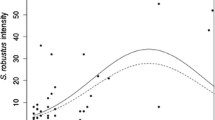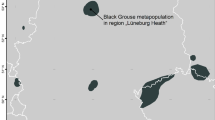Abstract
Prevalence and intensity of excretion of coccidial oocysts in actively migrating passerines (Turdus philomelos, Fringilla coelebs, Sylvia borin, Phoenicurus phoenicurus) were assessed in spring and autumn 2001 during stopovers on Helgoland. All examined species showed low prevalences of oocysts in spring (28–33%) and high prevalences in autumn migration (66–92%). In autumn, there are significant species-specific differences in prevalence and, partially, in intensity of excretion. Ground-feeding Chaffinches most commonly and most intensively shed oocysts (maximal 2,7×106 oocysts per g fresh faeces) indicating that feeding style may influence the parasite load. No significant correlation between parasite load, age, and body condition (fat depots, breast muscle shape, body mass) was found. The connection between feeding style, age, migration, immunocompetence, and survival of passerine hosts on one hand and the particularities of coccidial pathogenicity on the other are discussed.


Similar content being viewed by others
References
Åkesson S, Hedenström A, Hasselquist D (1995) Stopover and fat accumulation in passerine birds in autumn at Ottenby, southeastern Sweden. Ornis Svecica 5:81–91
Bairlein F (1991a) Nutritional adaptations to fat deposition in the long-distance migratory Garden Warbler Sylvia borin. Proc Int Ornithol Congr 20: 2149–2158
Bairlein F (1991b) Body mass of Garden Warblers (Sylvia borin) on migration: a review of field data. Vogelwarte 36:48–61
Bairlein F (1994) Manual of field methods. European-African songbird migration network. Institut für Vogelforschung, Wilhelmshaven.
Boughton DC (1933) Diurnal gametic periodicity in avian Isospora. Am J Hyg 18:161–184
Box ED (1977) Life cycles of two Isospora species in the canary Serinus canarius Linnaeus. J Protozool 24:57–67
Box ED (1981) Isospora as an extraintestinal parasite of passerine birds. J Protozool 28:244–246
Davidar P, Morton ES (1993) Living with parasites: prevalence and effects of a blood parasite on survivorship in the purple martin. Auk 110:109–116
Dawson RD, Bortolotti GR (2000) Effects of hematozoan parasites on condition and return rates of American Kestrels. Auk 117:373–380
Dierschke V, Bindrich F (2001) Body condition of migrant passerines crossing a small ecological barrier. Vogelwarte 41:119–132
Dolnik OV (1998) Isospora coccidia (Protozoa: Eimeriidae) of passerine birds on the Courish Spit. Bull Scand Soc Parasitol 8:58–59
Dolnik OV (2002) Some aspects of the biology and host-parasite interactions of Isospora spp. (Protozoa: Coccidiida) of passerine birds. Dissertation, University of Oldenburg
Dorrestein GM (1996) Medicine and surgery of canaries and finches. In: Rosskopf W, Woerpel R (eds) Diseases of cage and aviary birds. Williams and Wilkins, Baltimore, pp 915–927
Dorrestein GM, Kummerfeld N (1998) Singvögel—Endoparasiten. In: Gabrisch K, Zwart P (eds) Krankheiten der Heimtiere, 4th edn. Schlütersche, Hannover, pp 358–365
Gryczyńska A, Dolnik O, Mazgajski TD (1999) Parasites of Chaffinch (Fringilla coelebs) population. Part I. Coccidia (Protozoa, Apicomplexa). Wiad Parazytol 45:495–500
Hanssen SA, Folstad I, Erikstad KE, Oksanen A (2003) Costs of parasites in common eiders: effects of antiparasite treatment. Oikos 100:105–111
Jenni L, Winkler R (1994) Moult and ageing of European passerines. Academic Press, London
Kaiser A (1993) A new multi-category classification of subcutaneous fat deposits of songbirds. J Field Ornithol 64:246–255
Kroll H (1972) Zur Nahrungsökologie der Gartengrasmücke (Sylvia borin) beim Herbstzug 1969 auf Helgoland. Vogelwarte 26:280–285
Kruszewicz A, Dyrcz A (2000) Intestinal parasites in five species of the genus Acrocephalus. Acta Ornithol 35:153–158
Kummerfeld N (2003) Parasitäre Erkrankungen. In: Kaleta EF, Krautwald-Junghanns M-E (eds) Kompendium der Ziervogelkrankheiten, 2nd edn. Schlütersche, Hannover, pp 206–229
Levine ND (1982) The genus Atoxoplasma (Protozoa, Apicompolexa). J Parasitol 68:719–723
Mazgajski TD, Kędra AH (1998) Endoparasite Isospora sp. (Coccidia, Eimeriidae) affects the growth of starling Sturnus vulgaris nestling. Acta Parasitol 43:214–216
Milde K (1979) Light and electron microscopic studies on isosporan parasites (Sporozoa) in sparrows (Passer domesticus L.). Protistologica 15:607–627
Moritz D (1982) Langfristige Bestandsschwankungen ausgewählter Passeres nach Fangergebnissen auf Helgoland. Seevögel 3 [suppl]:13–24
Ottich I (2002): Nahrungsangebot und -nutzung durch frugivore Zugvögel auf Helgoland. Diplomarbeit, University of Frankfurt am Main
Pellérdy PL (1974) Coccidia and coccidiosis. Akademiai Kiadó, Budapest, Hungary
Raiss R (1976) Zur Nahrungsökologie der Singdrossel (Turdus ph. philomelos C.L. Brehm) auf dem Frühjahrszug in Helgoland. Zool Anz 196:201–211
Rommel M (2000) Protozoologische Methoden. In: Rommel M, Eckert J, Kutzer E, Körtling W, Schneider T (eds.) Veterinärmedizinische Parasitologie, 5th edn. Blackwell, Berlin, pp 61–68
Schaub M, Jenni L (2000) Body mass of six long-distance migrant passerine species along the autumn migration route. J Ornithol 141:441–460
Scholtyseck E (1956) Untersuchungen über die Coccidieninfektion bei Vögeln. Zentralbl Bakteriol Parasitenkd Infektionskr Hyg Abt 1 165:275–289
Schwalbach G (1959) Untersuchungen und Beobachtungen an Coccidien der Gattungen Eimeria, Isospora und Caryospora bei Vögeln mit einer Beschreibung von sechzehn neuen Arten. Arch Protistenkd 104:431–491
SPSS (1998) SPSS for Windows 8.0. SPSS, Chicago, Ill.
Svobodová M (1994) Isospora, Caryospora and Eimeria (Apicomplexa: Eimeriidae) in passeriform birds from Czech Republic. Acta Protozool 33:101–108
Svobodová M, Cibulková M (1995) Isospora sp. (Apicomplexa: Eimeriidae) in icterine warbler (Hippolais icterina, Passeriformes: Sylviidae): the possibility of parents to nestlings transmission. Acta Protozool 34:233–235
Valkiûnas G (1993) Pathogenic influence of haemosporidians and trypanosomes on wild birds in the field conditions: facts and hypothesis. Ekologija 1:47–60
Wetzel R (1951) Verbesserte McMaster-Kammer zum Auszählen von Wurmeiern. Tierärztl Umsch 6:209–210
Yakimoff WL, Gousseff WF (1938) Les coccidies du pinson (Fringilla coelebs L.). Ann Soc Belge Med Trop 18:523–525
Acknowledgements
Bird trapping on Helgoland was done by Thomas Bleifuss with the help of numerous volunteers. Stephan Selbach and Indra Ottich helped with the handling of birds separated for the examination of parasites. We are also grateful to O. Dolnik for reading the manuscript.
Author information
Authors and Affiliations
Corresponding author
Additional information
Communicated by F. Bairlein
Rights and permissions
About this article
Cite this article
Zinke, A., Schnebel, B., Dierschke, V. et al. Prevalence and intensity of excretion of coccidial oocysts in migrating passerines on Helgoland. J Ornithol 145, 74–78 (2004). https://doi.org/10.1007/s10336-003-0015-4
Received:
Revised:
Accepted:
Published:
Issue Date:
DOI: https://doi.org/10.1007/s10336-003-0015-4




